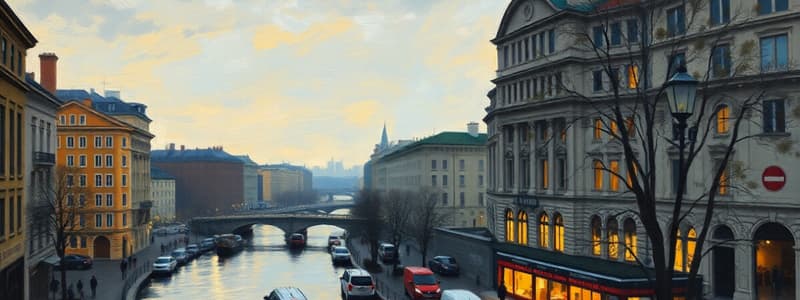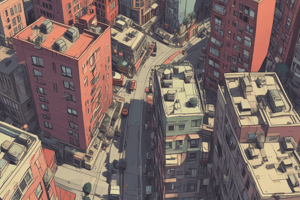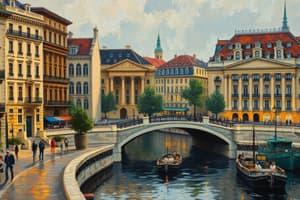Podcast
Questions and Answers
Which principle of smart growth involves protecting natural landscapes and recreational areas?
Which principle of smart growth involves protecting natural landscapes and recreational areas?
- Robust community engagement
- Development within existing neighborhoods
- Preserving open space (correct)
- Diverse housing options
What is one potential negative impact of smart growth?
What is one potential negative impact of smart growth?
- Gentrification and displacement (correct)
- Enhanced public transportation options
- Increased community involvement
- Lower property values
Smart growth encourages development within existing neighborhoods to enhance what aspect?
Smart growth encourages development within existing neighborhoods to enhance what aspect?
- Subsistence farming
- Rural tourism opportunities
- Efficiency of land use (correct)
- Strict zoning laws
Which of the following is NOT a component of smart growth?
Which of the following is NOT a component of smart growth?
What does the term 'urban growth boundary' refer to?
What does the term 'urban growth boundary' refer to?
Which benefit of smart growth is related to job accessibility?
Which benefit of smart growth is related to job accessibility?
What is a main characteristic of smart growth in terms of housing?
What is a main characteristic of smart growth in terms of housing?
Which challenge is associated with implementing smart growth on a national scale?
Which challenge is associated with implementing smart growth on a national scale?
What does gentrification primarily involve?
What does gentrification primarily involve?
What is infill in urban planning?
What is infill in urban planning?
What defines a metropolitan area?
What defines a metropolitan area?
Which term describes the small towns and farms located just outside a city's suburbs?
Which term describes the small towns and farms located just outside a city's suburbs?
What is the main characteristic of suburbs?
What is the main characteristic of suburbs?
What is urban sprawl characterized by?
What is urban sprawl characterized by?
What does mixed-use development refer to?
What does mixed-use development refer to?
Which area serves as the downtown or central business district of a city?
Which area serves as the downtown or central business district of a city?
Which of the following best describes urban fringe?
Which of the following best describes urban fringe?
Flashcards
Urban Core
Urban Core
The older, central part of a city, often bustling with businesses.
Gentrification
Gentrification
The process of renovating and modernizing older neighborhoods, sometimes displacing residents.
Metropolitan Area
Metropolitan Area
The areas surrounding a major city, often including suburbs and smaller towns.
Urban Fringe
Urban Fringe
Signup and view all the flashcards
Urban Sprawl
Urban Sprawl
Signup and view all the flashcards
Rural Fringe
Rural Fringe
Signup and view all the flashcards
Infill
Infill
Signup and view all the flashcards
Suburbs
Suburbs
Signup and view all the flashcards
Mixed-use development
Mixed-use development
Signup and view all the flashcards
Smart Growth
Smart Growth
Signup and view all the flashcards
Urban Growth Boundary
Urban Growth Boundary
Signup and view all the flashcards
Diverse Transportation Options
Diverse Transportation Options
Signup and view all the flashcards
Preserving Open Space
Preserving Open Space
Signup and view all the flashcards
Development within existing neighborhoods
Development within existing neighborhoods
Signup and view all the flashcards
Robust Community Engagement
Robust Community Engagement
Signup and view all the flashcards
Public Transportation System
Public Transportation System
Signup and view all the flashcards
Study Notes
Definitions
- Gentrification: The replacement of older neighborhoods with new construction, typically including commercial spaces (shops, businesses) and housing.
- Infill: Development in previously empty or underdeveloped portions of a city.
- Metropolitan Area: A large population center with a central city and surrounding suburbs/towns.
- Rural Fringe: The undeveloped areas like farms, small towns, and open spaces beyond the city's suburbs.
- Suburbs: Residential areas on the outskirts of a city, with some commercial and retail presence.
- Urban Core: The downtown or central business district of a major city, often older.
- Urban Fringe: The ring of suburbs and small towns immediately surrounding a large city.
- Urban Sprawl: The uncontrolled outward expansion of urban development into rural areas.
- Mixed-use Development: Combines various uses (residential, commercial, cultural, institutional, recreational) within a single building or area.
- Public Transportation System: A network of buses, trains, subways, or other forms of transportation for public use.
- Smart Growth: A strategy to create livable communities with a mix of housing types, transportation options, and access to daily needs, focusing on development within existing boundaries and preserving open space.
Pros and Cons of Urban Sprawl
- Urban sprawl involves rapid, often poorly planned, expansion of development into rural areas.
How Urban Sprawl Moves
- (no detail provided)
Urban Growth Boundary
- Urban growth boundaries establish geographical limits for development sprawl around a city, county, or broader region. Development is typically restricted outside these boundaries.
Smart Growth Principles
- Diverse housing and transportation options: Includes public transportation, biking, walking, and well-maintained roads/bridges.
- Preserving open space: Protecting natural areas, farmland, parks, wetlands, and prairies.
- Development within existing neighborhoods: Focusing on building in existing communities to optimize existing infrastructure/services.
- Robust community engagement: Involving residents/stakeholders in the planning and development process.
Smart Growth Benefits and Drawbacks
- Benefits: Increased tax base, closer proximity of jobs/services, reduced development pressure in fringe areas.
- Drawbacks: Potential for gentrification (displacing low-income residents, particularly those of color), lack of national policy support.
Studying That Suits You
Use AI to generate personalized quizzes and flashcards to suit your learning preferences.





